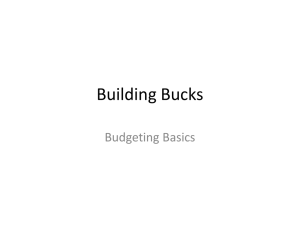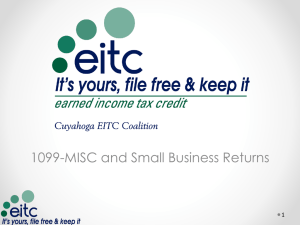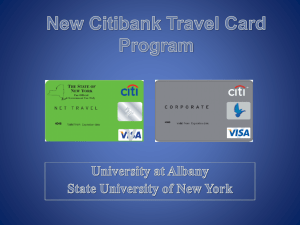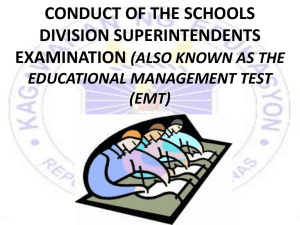to accompany lesson procedures - Federal Reserve Bank of Atlanta
advertisement
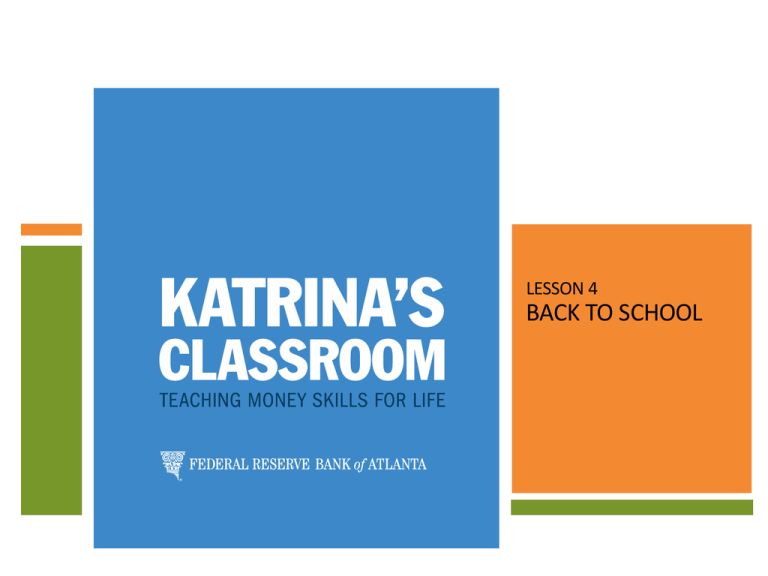
LESSON 4 BACK TO SCHOOL LESSON 4: BACK TO SCHOOL LESSON OBJECTIVES STUDENTS WILL: 1. ANALYZE GRAPHS AND CHARTS RELATED TO EDUCATION AND SAVING. 2. ARTICULATE REASONS AND GOALS FOR SAVING. 3. EVALUATE THE OPPORTUNITIES AND EXPENSES ASSOCIATED WITH POSTSECONDARY EDUCATION. 4. EXPLAIN AND USE THE VOCABULARY ASSOCIATED WITH POSTSECONDARY EDUCATION, BUDGETING, AND SAVING. 5. IDENTIFY POSTSECONDARY INSTITUTIONS THAT OFFER SPECIFIC PROGRAMS OF STUDY. 6. IDENTIFY THE PURPOSE OF A BUDGET. 7. IMPLEMENT THE BUDGETING STEPS. 8. PERFORM CALCULATIONS FOR GROWTH OF FUNDS. 9. RECOGNIZE THAT HIGHER EDUCATION IS THE KEY TO GREATER INCOME OVER A LIFETIME. 10.RECOGNIZE THE NEED FOR FINANCIAL PREPAREDNESS IN THE FACE OF A DISASTER. 11.UNDERSTAND THE RELATIONSHIP BETWEEN HUMAN CAPITAL AND INCOME. 2 HUMAN CAPITAL AND EDUCATION 3 Lesson 4: Back to School HUMAN CAPITAL: INVEST IN YOURSELF Human capital is the knowledge, skills, and training that people possess. • There is a strong correlation between the level of a person’s human capital and that person’s income. • Invest in human capital by going to school, pursuing additional training, and developing skills. 4 Lesson 4: Back to School YOUR HUMAN CAPITAL Current human capital Future human capital Areas and subjects in which you have a lot of knowledge Education Additional training Employment Other skills REFLECTION QUESTIONS • How does your current human capital differ from your future human capital? • What steps do you need to take to achieve your future human capital? 5 Lesson 4: Back to School HOW LONG WILL IT TAKE TO EARN $1 MILLION? How much each year? (2012 Median Annual Salary) Level of Education Estimate Actual How many years to earn $1 million? Estimate Actual Less than high school diploma $24,492 40.8 High school diploma $33,904 29.5 Some college, no degree $37,804 26.5 Associate’s degree $40,820 24.5 Bachelor’s degree $55,432 18.0 Master’s degree $67,600 14.8 Professional degree $90,220 11.1 Doctoral degree $84,448 11.8 Source: Current Population Survey (U.S. Bureau of Labor Statistics, bls.gov/emp/ep_chart_001.htm) 6 Lesson 4: Back to School GRAPH: HOW LONG WILL IT TAKE TO EARN $1 MILLION? Years to Earn $1 Million By Education Level 45 40 40.8 35 Number of Years 30 25 20 15 10 29.5 25 26.5 23 24.5 22 20 Potential Estimate 18 15 14.8 13 Actual 11.1 9 11.8 8 5 0 Level of Education and 2012 Annual Median Source: Current Population Survey (U.S. Bureau of Labor Statistics, bls.gov/emp/ep_chart_001.htm ) 7 Lesson 4: Back to School EARNINGS, UNEMPLOYMENT RATES, AND EDUCATION Source: Current Population Survey (U.S. Bureau of Labor Statistics , bls.gov/emp/ep_chart_001.htm) 8 Lesson 4: Back to School TEEN UNEMPLOYMENT RATES Average Unemployment Rate by Year Unemployment Rate = Number of unemployed / Labor force Note: Labor Force = Number of employed + number of unemployed 30.0 Average Unemployment Rate 25.0 20.0 15.0 10.0 5.0 0.0 2003 2004 2005 2006 2007 2008 2009 2010 2011 2012 16 years and over 6.0 5.5 5.1 4.6 4.6 5.8 9.3 9.6 8.9 8.1 2013 (Based on Jan-Oct) 7.5 16 to 19 years 17.4 17.0 16.5 15.3 15.7 18.7 24.3 25.8 24.4 24.0 23.5 Source: Employment Situation Historical Data (U.S. Bureau of Labor Statistics , bls.gov/cps/cpsatabs.htm) 9 Lesson 4: Back to School EDUCATION PAYS… BUT IT ALSO COSTS • $8,655 = Average yearly tuition and fees at a public four-year college • $8,655 x 4 years = $34,620 total • 70% of college seniors graduated with debt from student loans. • The average debt load was $29,400. Sources: College Costs FAQ (College Board, bigfuture.collegeboard.org/pay-for-college/college-costs/college-costsfaqs) and the Project on Student Debt (projectonstudentdebt.org/state_by_state-data.php) 10 Lesson 4: Back to School STUDENT LOAN RULE OF THUMB A suggestion: Don’t borrow more money for all the years of your postsecondary education than you anticipate making in your first year of employment. For a public relations manager: • Requirement: Bachelor’s degree • Starting salary: <$30,500 • Median salary: $91,810 Sources: Bureau of Labor Statistics Occupational Outlook Handbook (www.bls.gov/ooh/) 11 Lesson 4: Back to School PAYING FOR COLLEGE: DO YOUR HOMEWORK • Scholarships • Grants • Work study • Savings • Student loans 12 Lesson 4: Back to School PLANNING FOR POSTSECONDARY EDUCATION • Complete an interest inventory. • Identify career goals. • Research postsecondary options. • Research the application process. • Research strategies to finance your education. 13 Lesson 4: Back to School ACTIVITY: EVALUATING POSTSECONDARY OPPORTUNITIES AND EXPENSES Scenario: You are exploring options for attending college next year to obtain a bachelor’s degree for your chosen career (see the career card). • Cost is a major factor in your decision. • Scholarships, together with help from your parents, will cover half the expenses. • You will pay for the other half with student loans. • You will attend school in your home state. • You have not yet decided whether to live on or off campus. 14 Lesson 4: Back to School 1 1 15 Lesson 4: Back to School 1 2 3 4 16 Lesson 4: Back to School 5 1 4 3 2 6 17 Lesson 4: Back to School 1 2 18 Lesson 4: Back to School ACTIVITY: EVALUATING POSTSECONDARY OPPORTUNITIES AND EXPENSES DEBRIEFING • What career option did you evaluate? • What school was selected as the best alternative for this career and why? • What is the opportunity cost of this decision? • Will the entry-level salary support the estimated student loan payment? Why or why not? • What are some strategies to reduce the amount borrowed to finance post-secondary education? 19 Lesson 4: Back to School BACK TO SCHOOL 5 Lesson 4: Back to School ASSESSING THE IMPACT OF FINANCIAL PREPAREDNESS • What did Jamie’s friend’s recommend in order to be financially prepared? • How was Jamie able to use the money she had earned and saved? • How might having a budget help you achieve your financial goals? • How might getting a good education help ensure your financial future? 21 BUDGETING 22 Lesson 4: Back to School MANAGING YOUR MONEY: THE BUDGET WHAT IS A BUDGET? • A budget is a plan that helps you manage your money by helping you balance your income with your expenses. • It is an itemized summary of probable income and expenses for a given period. WHY CREATE A BUDGET? • A budget helps you understand where your money goes. • It helps you live within your means and meet your goals. • It helps you find uses for your money that will increase your wealth. • It puts you in control of your money. 23 Lesson 4: Back to School MANAGING YOUR MONEY: THE BUDGET Determine Income Review & Adjust Implement & Track Identify Expenses & Track Spending Develop the Budget Plan 24 Lesson 4: Back to School THE BUDGET: DETERMINE INCOME • Calculate your income. • Identify all income sources. • Wages/salaries Determine Income • Gifts or allowance • Interest • Scholarships, grants, and student aid • Understand the difference between net and gross income. 25 Lesson 4: Back to School THE BUDGET: IDENTIFY EXPENSES AND TRACK SPENDING DETERMINING YOUR EXPENSES • Consider all expenses. • Determine which are fixed and which are variable expenses. EXPENSE CONSIDERATIONS • Know what you owe. • Consider your ongoing needs. Identify Expenses & Track Spending • Plan other expenditures. • Identify how much money you need to cover expenses. • Expect the unexpected. 26 Lesson 4: Back to School TRACKING YOUR EXPENSES WHERE DID YOUR MONEY GO? Example purchase On what? A large caramel latte Where? Specialty coffee store How much? $4.75 How paid? Cash 27 Lesson 4: Back to School ACTIVITY: TRACKING YOUR EXPENSES TRACK DAILY EXPENSES FOR THE PAST TWO DAYS Date Item Purchased/ Expense Amount Payment Method Cash, Check, ATM/Debit Card, Credit Card, Autodraft, etc. Fixed or Variable Expense 10/1 Car payment $250 Autodraft Fixed 10/1 Gas $40 Debit card Variable 10/2 Car insurance $150 Check Fixed 10/2 Lunch $5 Cash Variable 28 Lesson 4: Back to School ACTIVITY: TRACKING YOUR EXPENSES DEBRIEFING • What types of goods and services did you purchase? • What types of payment methods did you use? • Did the way you paid affect how much you spent? • Which expenses were fixed and which were variable? • Any surprises regarding how much you spent? • What income did you have that paid for these expenses? • Did tracking make you rethink any of your purchases? • What influenced your spending—people, situation, emotion? • How did the purchase make you feel? What about now? 29 Lesson 4: Back to School THE BUDGET: DEVELOP THE BUDGET PLAN • Information already gathered: • Income • Fixed and variable expenses Develop the Budget Plan • Other considerations: • Pay yourself first—savings • Consider your goals • Budget shortfalls 30 Lesson 4: Back to School CREATE A BUDGET How much money do you get each month? $2,000 Income Fixed Expenses Rent Cell Phone Car insurance ($300/quarter) $ 600 $ 40 $ 100 Fixed Expenses Variable Expenses Food (estimate) Utility bills (estimate) Gas $ 500 $ 50 $ 50 Variable Expenses Total Expenses $1,540 Income What expenses do you have each month? 31 Lesson 4: Back to School ACTIVITY: BUDGET SCENARIOS • In this activity, you will work in groups to allocate $2,000 to a monthly budget estimate. • You will then take turns drawing scenario cards to see how close you came to estimating expenses. • Once you have drawn all of the cards, answer the questions at the bottom of the worksheet. 32 Lesson 4: Back to School ACTIVITY: BUDGET SCENARIOS Income Estimate Net income Actual $2,000 Fixed Expenses Rent Renter’s insurance Automobile loan payment Automobile insurance Medical insurance Student loan Total Fixed Expenses $450 $25 $250 $75 $100 $325 $1,225 Variable Expenses $200 $75 $125 Groceries Dining out Utilities Gasoline Car maintenance Clothing and personal upkeep Gifts Entertainment Savings Total Variable Expenses Total Expenses SURPLUS (DEFICIT) $75 $75 $25 $100 $10 $75 $760 $1,985 $15 33 Lesson 4: Back to School ACTIVITY: BUDGET SCENARIOS DEBRIEFING • How did your group’s estimates differ from the scenarios? • How much did you estimate as savings each month? • Were there expenses on this budget that were not listed in the categories provided? • If you had to pay for these expenses, where would the money come from? 34 Lesson 4: Back to School THE BUDGET: IMPLEMENT AND TRACK • Implement the budget. • Continue to track spending. Implement & Track 35 Lesson 4: Back to School THE BUDGET: REVIEW AND ADJUST Review the budget at least monthly. Make necessary adjustments for your situation. Review & Adjust Consider the following in your review: • Have income sources changed? • Does your income cover your expenses? • Where and when are you spending money? • Are you saving regularly? • Has anything affected your income, spending, and saving? • Are you achieving your personal and financial goals? 36 SAVING 37 Lesson 4: Back to School SAVING VERSUS INVESTING WHAT IS SAVING? • Savings = Disposable income – Consumption. • It is the preservation and protection of money from loss. • It helps you meet short-term goals and needs. • It helps you prepare for the unexpected. WHAT IS INVESTING? • It is a long-term commitment to put money away and let it grow. • You are taking a risk with a portion of your savings, such as by buying stocks or bonds, in hopes of realizing higher long-term returns. 38 Lesson 4: Back to School REASONS FOR SAVING • To build an emergency fund • To cover budget shortfalls • To meet future needs • To achieve personal and financial goals • To keep funds secure while increasing them 39 Lesson 4: Back to School YOUR GOALS FOR SAVING • List three things you want that may require you to save money in order to buy them. • How much will each item cost you? • How long do you estimate it will take you to save for each item? • How much per week/month will you need to save? • How will this impact your budget? • What might you have to give up to attain these items? 40 Lesson 4: Back to School TOOLS FOR SAVING • Savings account • Certificate of deposit • Money market account • Savings bonds 41 Lesson 4: Back to School COMPOUND INTEREST: DAILY VS. MONTHLY VS. YEARLY Principal = $1,000 (year 1 only) ~ Interest Rate = 5% ~ Term = 5 Years Growth of $1,000 Deposit at Varying Compounding Intervals $1,284 $1,283 $1,276 Year 5 $1,221 $1,221 $1,216 Year 4 $1,000 Compounded Yearly (Total Interest = $276) $1,105 $1,105 $1,103 Year 2 Year 1 Compounded Monthly (Total Interest = $283) $1,162 $1,161 $1,158 Year 3 Compounded Daily (Total Interest = $284) $1,051 $1,051 $1,050 $1,050 $1,100 $1,150 $1,200 $1,250 $1,300 42 Lesson 4: Back to School WATCH IT GROW: RULE OF 72 With the rule of 72, you can estimate the growth of funds over time with compound interest. You calculate the length of time (in years) for a principal deposit to double. You divide 72 by the rate of return. EXAMPLE: • Say you deposit $5,000 today at an 8% interest rate. • Apply the rule: 72 ÷ 8 = 9 • The principal will double every 9 years. 43 Lesson 4: Back to School RULE OF 72 CALCULATIONS: PROBLEM #1 If you deposit $50,000, how many years will it take for it to grow to $100,000? At 4% annual interest • 72 ÷ 4 = 18 years At 6% annual interest • 72 ÷ 6 = 12 years At 9% annual interest • 72 ÷ 9 = 8 years At 12% annual interest • 72 ÷ 12 = 6 years 44 Lesson 4: Back to School RULE OF 72 CALCULATIONS: PROBLEM #2 What interest rate do you need to grow $50,000 to $100,000? IN 2 YEARS? • 72 ÷ 2 = 36% IN 5 YEARS? • 72 ÷ 5 = 14.4% IN 10 YEARS? • 72 ÷ 10 = 7.2% IN 20 YEARS? • 72 ÷ 20 = 3.6% 45 Lesson 4: Back to School VOCABULARY REVIEW WORD DESCRIPTION WORD BANK Compound Interest Interest Interest Rate Principal Rule of 72 Simple Interest Term Principal 1. The original amount of money deposited Interest 2. Money an institution pays you for use of your funds Interest Rate 3. Expressed as a percentage, what an account will earn if funds are kept on deposit for an agreed-upon term Simple Interest 4. Interest paid only on the principal amount deposited into the account Compound Interest 5. The method of computing interest where the interest rate is applied to the principal and any earned interest; often referred to as “interest on interest” Term 6. Length of time money left on deposit in account Rule of 72 7. A calculation that estimates growth of funds over time with compound interest 46 Lesson 4: Back to School IN SUMMARY Human capital is the knowledge, talent, and skills that people possess. Education can increase human capital and earning potential as well as decrease unemployment risk. Planning for postsecondary education includes considering career goals, postsecondary options, financing strategies, and necessary documentation. Budgeting puts you in control of your money and helps you understand the allocation of your income. Saving allows you to meet short-term goals and to prepare for the unexpected. 47 Katrina’s Classroom was developed by a team of Senior Economic and Financial Education Specialists at the Federal Reserve Bank of Atlanta. Claire Loup, New Orleans Branch Julie Kornegay, Birmingham Branch Jackie Morgan, Nashville Branch For additional classroom resources and professional development opportunities, please visit www. frbatlanta.org/edresources 48
